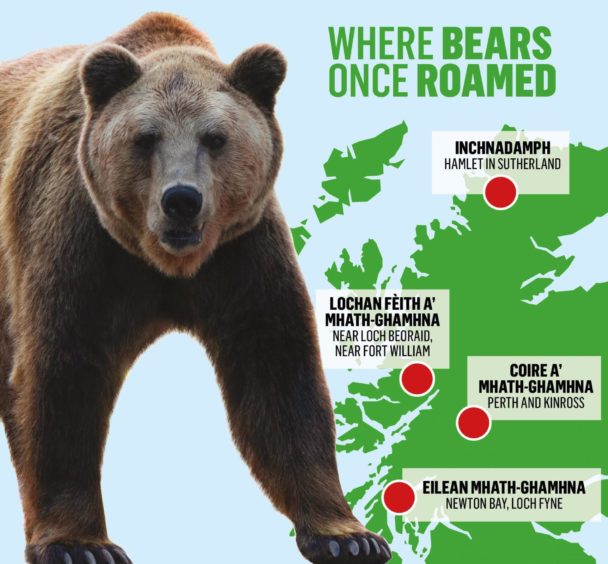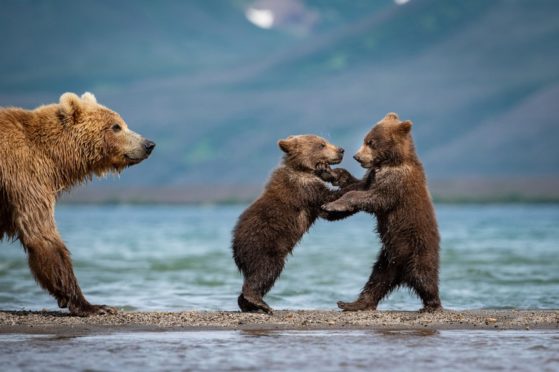A survey of place names have revealed where bears used to roam Scotland’s landscape.
In a blog for NatureScot, an expert said it is far from clear when European brown bears became extinct in Scotland, and it was “therefore fascinating that there are several Scottish place names that might recall in some way or other a human familiarity with those iconic mammals”.
It comes amid controversial moves to bring them back to the Scottish countryside.
Ecologist David Hetherington, an expert on extinct species once native to the UK, says that we know “from a scattering of bones left behind in caves and peat bogs, from Dumfriesshire in the south to Caithness in the north, that Scotland once had brown bears”.
The youngest Scottish bear bone so far carbon-dated, a femur found in the bone caves near Inchnadamph in the north-west Highlands, is around 2,700 years old.

A fascinating corollary to this narrative is that one of the possible “bear” place names in Scotland is very close to the Inchnadamph caves.
“Of course, these remains recall an ursid presence in our environment that pre-dates our place names by some distance, but we do know that bears occurred here into historic times,” said the Inverness-based writer, broadcaster and storyteller Roddy Maclean.
“Caledonian bears were taken by the Romans to appear in public entertainments in the Colosseum, and the animal appears on Pictish stone carvings from around the 8th and 9th centuries AD.
“David Hetherington speculates that the species survived here until the 15th or 16th centuries. In Carmina Gadelica Vol II, the folklore-collector Alexander Carmichael claims that ‘the bear was common in Scotland down to 1545, probably later’ although he offers no evidence to back this up. He recorded incantations and fragments of Gaelic poetry which mention the bear.”
Place names with clues to bears include Coire a’ Mhath-ghamhna “the corrie of the bear”, north-west of Loch Lyon in Perthshire.
Another example is to be found in a remote location in Morar, in the hills between Lochs Morar and Beoraid. Lochan Fèith a’ Mhath-ghamhna – “the lochan of the bog of the bear”, is given on the first OS 6-inch map – published in 1876.
The third similar example in the landscape is the small tidal islet of Eilean Math-ghamhna “bear island” at Newton Bay on the southern shore of Loch Fyne in Cowal, Argyll.
Mr McLean added: “The element ‘mathan’ appears in two locations in Assynt.
“The first is Allt Mhathain, presumably for Allt a’ Mhathain ‘the burn of the bear’.
“This small stream meanders from Loch na Bà Brice, ‘the loch of the speckled cow’, to meet Abhainn Gleann Leireag near the village of Nedd.
“Intriguingly, it is not far distant from the famous Bone Caves at Creag nan Uamh, ‘the crag of the caves’, in Inchnadamph, where significant discoveries were made of prehistoric bear bones.
“The second Assynt name is even more convincing. Cnoc Eilid Mhathain appears to mean ‘hill of the she-bear’.
“Its location demands attention. It is a very short distance – a mere bear-ramble – from the bone caves at Creag nan Uamh. Not only that, but the mountain midway between Cnoc Eilid Mhathain and the caves is called Beinn nan Cnàimhseag.
“This translates as ‘the mountain of the bearberries’ – a species known to be a favourite bear-food.
“The plant is relatively abundant in this part of the country; indeed, a short distance to the south-west there is Druim nan Cnàimhseag ‘the ridge of the bearberries’.
“This evidence tempts one to suggest that Assynt might have been the place where Scottish bears made their final stand.”
The place-name Bearsden – a town in East Dunbartonshire – remains unexplained but is unlikely to be connected to wild bears.
And other “bear” names in south-western Scotland, such as Bearburn and Bearmeal Knowe are most likely derived from bere, which was once commonly cultivated.
